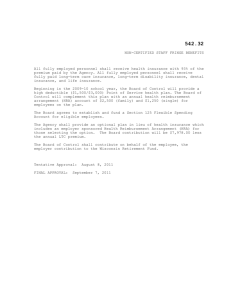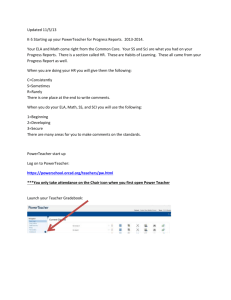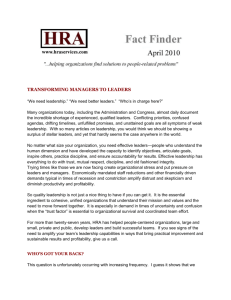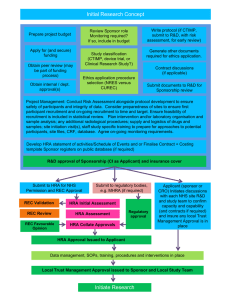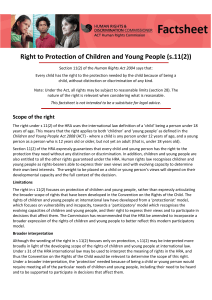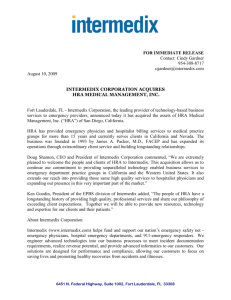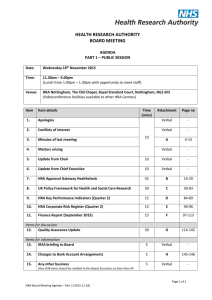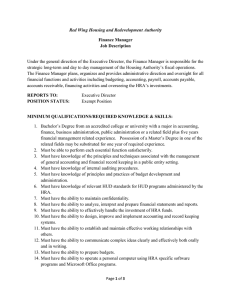6 om as a public service of the RAND Corporation.
advertisement
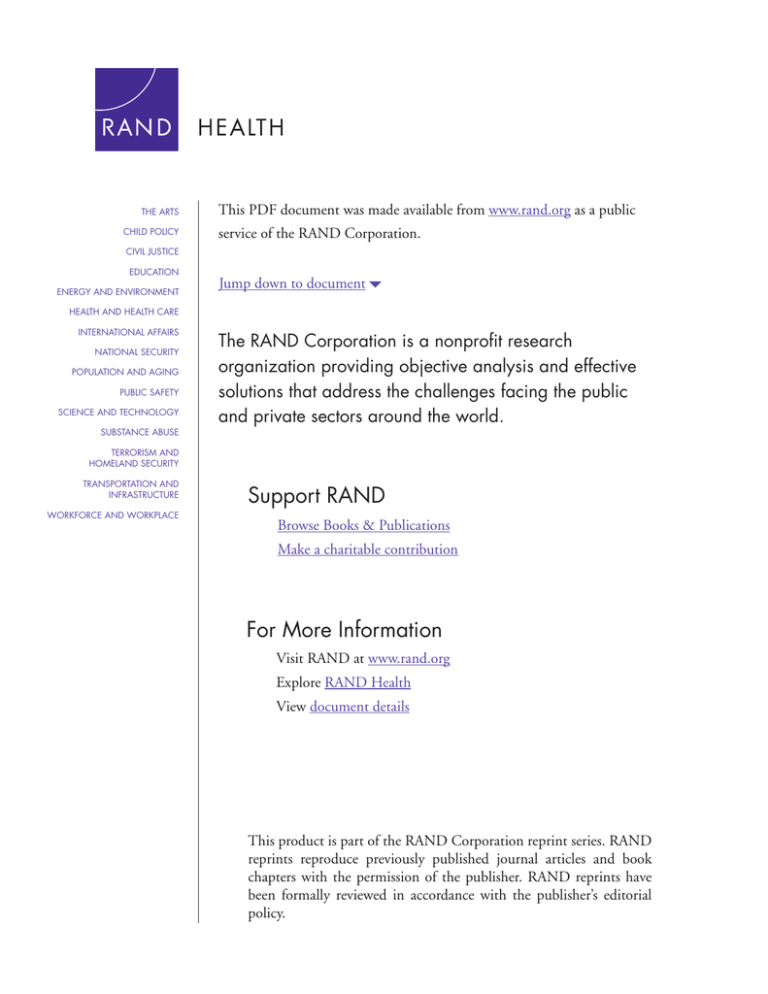
THE ARTS CHILD POLICY This PDF document was made available from www.rand.org as a public service of the RAND Corporation. CIVIL JUSTICE EDUCATION ENERGY AND ENVIRONMENT Jump down to document6 HEALTH AND HEALTH CARE INTERNATIONAL AFFAIRS NATIONAL SECURITY POPULATION AND AGING PUBLIC SAFETY SCIENCE AND TECHNOLOGY SUBSTANCE ABUSE The RAND Corporation is a nonprofit research organization providing objective analysis and effective solutions that address the challenges facing the public and private sectors around the world. TERRORISM AND HOMELAND SECURITY TRANSPORTATION AND INFRASTRUCTURE WORKFORCE AND WORKPLACE Support RAND Browse Books & Publications Make a charitable contribution For More Information Visit RAND at www.rand.org Explore RAND Health View document details This product is part of the RAND Corporation reprint series. RAND reprints reproduce previously published journal articles and book chapters with the permission of the publisher. RAND reprints have been formally reviewed in accordance with the publisher’s editorial policy. EVIDENCE REPORT AND EVIDENCE-BASED RECOMMENDATIONS: HEALTH RISK APPRAISALS AND MEDICARE Southern California Evidence-Based Practice Center Santa Santa Monica Monica Los Los Angeles Angeles San San Diego Diego PREPARED FOR: U.S. DEPARTMENT OF HEALTH AND HUMAN SERVICES HEALTH CARE FINANCING ADMINISTRATION 7500 Security Blvd. Baltimore, MD 21244-1850 PREPARED BY: RAND CONTRACT NUMBER: 500-98-0281 CONTRACT PERIOD: October 30, 1998 to September 29, 2003 EXECUTIVE SUMMARY INTRODUCTION The evidence linking lifestyle to health and function is indisputable and continues to grow. The need for systematic and comprehensive approaches to health that identify and address not just essential clinical services, but also lifestyle changes, is important. One promising approach that targets both needed clinical services and lifestyle behaviors is the health risk appraisal. Health Risk Appraisal (HRA) is a systematic approach to collecting information from individuals that identifies risk factors, provides individualized feedback, and links the person with at least one intervention to promote health, sustain function, and/ or prevent disease. A typical HRA instrument obtains information on demographic characteristics (e.g., sex, age), lifestyle (e.g., smoking, exercise, alcohol consumption, diet), personal medical history, and family medical history. In some cases, physiological data (e.g., height, weight, blood pressure, cholesterol levels) are also obtained. The Health Care Financing Administration (HCFA) commissioned this report to evaluate the potential effectiveness of HRA and programs using HRA as a health promotion tool, and to provide evidence-based recommendations regarding the use of HRA in health promotion programs for older adults. Specifically, HCFA asked RAND to address the following questions: 1. How good is the evidence that HRA interventions have beneficial effects? Do they have a positive impact on quality of life, health status, health outcomes, and satisfaction? 2. What is the value of different levels of intensity in follow-up (e.g., a self-management book vs. self-management book and nurse follow-up phone calls or community referrals)? 3. What are the key features of HRA surveys and follow-up interventions? 1 4. Do HRA interventions reduce health care costs by reducing disease and utilization of services? 5. Does the evidence suggest that HRAs should be delivered to the whole population or to selected subsets, such as high-risk individuals? 6. What are special variations of HRAs for the older adult population? 7. What is the role of technology in HRA administration? 8. How have issues of confidentiality and privacy been addressed? 9. Does the integration of social, public health, and medical approaches enhance healthy aging? Does the opportunity to integrate these three approaches exist through HRAs? The final question was determined to be beyond the scope of this evidence-based report. However, a report from the Institute of Medicine1 recommends a social environmental approach to health and health interventions, which is worth mentioning as it relates to this question. METHODS In order to answer the questions, an extensive literature review was undertaken using the following steps: x identify sources of evidence (in this case, sources of scientific literature) x identify potential evidence x evaluate potential evidence for methodological quality and relevance x extract study-level variables and results from studies that meet methodological and clinical criteria x synthesize the results. RAND staff searched Medline, PsycINFO, PsychLit, Embase, Social Science Abstracts, and Current Contents for literature on HRAs. We also searched the Internet using the search engine Metacrawler. Upon receiving articles, RAND staff reviewed each reference list for additional relevant articles. The reference lists of the review articles demonstrated that the 2 largest single source of published material about HRAs was the Annual Proceedings of the Society for Prospective Medicine (SPM). The Society sent RAND all locatable proceedings from prior conferences that had been referenced in the review articles. We also ordered entire proceedings from the two most recent conferences (1998 and 1999) as well as the newly published “SPM Handbook of Health Assessment Tools." Finally, RAND staff presented a preliminary draft report to an expert panel, and several members sent additional articles that the initial search had not identified. Two researchers independently reviewed each article to determine whether to include it in the evidence synthesis. To be included, the HRA intervention had to a) deliver feedback to the client, b) be based on client self-report, and c) cover multiple domains. The term “domains” refers to health conditions or risks, such as prevention of cardiovascular disease or use of seat belts to prevent injury due to accidents. Furthermore, the feedback had to consist of specific recommendations for action. Finally, in order to be included in our analysis of the evidence on behavioral, health screening, physiological, and psychological outcomes, the study had to include a control group. Uncontrolled studies and descriptive pieces are included in the response to the question about technology due to lack of controlled studies in this area. Although we were primarily searching for data relevant to the Medicare population, studies of populations under age 65 were included to avoid premature loss of potentially useful data. The evidence was too sparse and/or too heterogeneous to support statistical pooling. Thus, this summary of the evidence is qualitative rather than quantitative. 3 RESULTS Based on the literature search and expert panel feedback, a total of 267 journal articles, unpublished reports, and conference presentations were requested. Of the 256 documents that could be obtained, 95 did not report studies of actual health risk appraisals (i.e., they studied comprehensive geriatric assessments, the PRA [Probability of Repeat Admission] instrument, and assorted health education materials). Forty-four other publications reported on tools that were defined by the authors as HRA but did not meet screening criteria (i.e., not based on self-report, no feedback given to patient, or restricted to a single domain). Another 37 articles were reviews, background information, or simple descriptions of an HRA. This left 80 publications that reported on research studies. Twenty-nine of the 80 publications reported on controlled trials. A few articles reported on the same study, thus 27 studies were represented. These studies are included in the review of the evidence for effectiveness. Thirteen studies were randomized controlled trials (RCTs), four were controlled clinical trials (CCTs) and ten were controlled before and after studies (CBAs). The remaining articles reported on uncontrolled studies (cohort, simple pre/post) or studies that did not report health or behavioral outcomes (i.e. reports of validity, reliability, or ease of administration). The quality of the included studies is mixed. Only half the controlled studies reported the percentage of eligible, contacted individuals who agreed to participate in the study. These percentages ranged from 15% to over 70%. All studies reported retention rates at follow-up; 17 of the 27 articles reported at least 70% retention for all groups. Length of follow-up ranged from 1 to 48 months. 4 Responses to the questions posed by HCFA are summarized below. QUESTION 1. How good is the evidence that health risk appraisals have beneficial effects? Do HRA interventions have a positive impact on quality of life, health status, health outcomes, and satisfaction? The effects of HRA interventions on the following types of outcomes were investigated: behavioral, use of cancer screenings, physiological, health status, and psychological. Together, results from these studies provide evidence for the potential benefit of HRA interventions on behavior (particularly exercise), physiological variables (particularly blood pressure and weight), and general health status. Results vary across studies. The reasons for differing results are not known, but may include that different measures were used to assess similar outcomes, and studies used varying levels of follow-up, making direct comparisons difficult. Less evidence was found for beneficial effects of HRA on screening utilization and psychological outcomes than for other desired changes. The most consistent evidence for HRA effectiveness on behavioral variables comes from studies of exercise habits. Eleven studies reported a beneficial effect on exercise habits, one reported a negative effect, and five reported no significant group differences. However, the use of different exercise measures across studies makes direct comparisons difficult and, in some studies, the clinical importance of the observed increase in exercise is questionable. Less consistent results were found for other commonly studied behaviors, with significant beneficial effects found for 6 of 15 smoking behavior studies, 2 of 9 alcohol use studies, and 1 of 4 diet studies. 5 Physiological parameters investigated in more than one study include body-mass index (BMI), weight, or percent body fat; blood pressure; and cholesterol level. Beneficial effects were found in seven of the 14 blood pressure studies, with more of an effect found for diastolic blood pressure than in systolic blood pressure. Further, seven of the 16 controlled studies that investigated BMI, weight, or body fat found a beneficial effect of HRA interventions. Of the small number of studies focusing on cholesterol, beneficial effects of HRA interventions were found in two (of seven) studies. Assessments of health status used in more than one of the eleven relevant controlled studies include HRA risk age, general health status, number of sick or disability days, risk of heart disease, risk of cancer, and mortality risk. All three studies that included a measure of general health status found a beneficial effect, as did three of the five studies focusing on HRA risk age. Only six studies investigated whether HRA prompted individuals to obtain health screenings (e.g., breast exam, pap smear, rectal exam, etc) and seven studies focused on psychological distress (e.g., anger, anxiety, depression, and stress). These small groups of studies do not contain sufficient evidence to draw firm conclusions about the effectiveness of HRA interventions on health screening outcomes or psychological distress. QUESTION 2 AND 3. What is the value of different levels of intensity in follow-up? What are the key features of HRA surveys and follow-up interventions? To further evaluate the effectiveness of programs using HRA, we classified the studies in terms of the intensity of the intervention. The least intensive interventions involved providing HRA feedback to participants (sometimes combined with providing standard educational materials). More extensive interventions involved providing HRA feedback with some type of 6 supplemental counseling from a physician, health educator, or other individual. The most extensive interventions provided HRA feedback plus the opportunity to participate in a health promotion program. Within these broad categories, considerable variation exists across studies in the extent of involvement in the intervention, availability of materials and programs to participants, and length of follow-up. However, the data suggest that more intensive interventions yield better results. Feedback Only. Ten controlled studies included a group that received HRA with feedback only. These studies found very limited benefit from HRA feedback alone on the parameters under investigation. Feedback plus counseling. Eleven controlled studies investigated the effects of receiving HRA feedback plus counseling. The feedback and counseling was provided by a physician in five studies and by a nurse in two studies. Other studies referred to the person who provided the feedback as a “health educator" or did not specify the background of the person. Several of these studies found no effect or effects on a very limited number of the health parameters under investigation. One study found that participants who received counseling and those who received counseling plus monetary incentives for behavior change had higher smoking cessation rates and smaller increases in BMI than did two groups who did not receive counseling. However, no differences were observed between the “counseling” and “no counseling” groups with respect to changes in percent body fat, blood pressure, cholesterol, or aerobic capacity (a measure of fitness). Further, it is not clear from these results whether counseling alone without additional monetary incentives has beneficial effects on these health parameters. 7 Feedback plus health promotion programs. Fourteen controlled studies combined HRA feedback with the opportunity to engage in a health promotion program. Many of these programs showed initial promise, although evidence for their long-term effectiveness is less strong. All five studies that used the most robust design (RCT) showed significant benefits of combining HRA with participation in a health promotion program. In addition, all five focused on older adults. Participants in four of the studies were Medicare beneficiaries, while the fifth study involved Bank of America retirees. Results are briefly described below. In the 1980s, HCFA funded a congressionally mandated demonstration project that included preventive services for Medicare beneficiaries. In each of five geographic areas patients completed an HRA, although use of the information differed widely. The projects were evaluated by both the study team and Abt Associates.2 At one site, Mayer and colleagues found significantly greater improvements among individuals who completed an HRA and were offered an 8-week health promotion workshop compared to those who completed an HRA and received only usual care, on a number of health-related parameters at 12-month follow-up.3 By the 24and 48-month follow-ups, the beneficial effects of the intervention remained for metabolic rate and engagement in stretching exercises and metabolic rate.4 At another location, Patrick and colleagues compared “usual care” to a package of preventive services that included HRA, a health-promotion visit, a disease-prevention visit, and follow-up classes.5 At the 24-month follow-up, this study found that the intervention group showed significantly greater improvement than did the control group on the following healthrelated parameters: physical activity (27% vs. 21% improved, respectively), obtaining flu shots (17% vs. 12% improved, respectively), quality of life, global health status, depression, and health worry. At the 48-month follow-up, the effects for flu shots, depression, and health worry 8 remained. Group differences were not found for other health-related behaviors, including smoking, alcohol, diet, seat belt use, home safety, medication awareness, breast self-exam, BMI, total health care costs, and stress. At another HCFA demonstration site, Williams and colleagues utilized HRA feedback by a health educator, educational materials, an 8-week workshop, booster telephone calls, and a newsletter.6 After four years, the intervention group showed greater improvements in metabolic rate, self-reported stretching activity (from 15 to 20 minutes per week), depression, and immunization rate compared to a group who completed an HRA only (differences were not found on diet, BMI, or blood pressure). Leigh and colleagues reported on the effects of the 12-month Healthtrac intervention among a group of Bank of America retirees.7 Of the interventions we reviewed, Healthtrac is the only one delivered exclusively through the mail. Participants in this study completed an HRA and received feedback every 6 months. The feedback consisted of a personalized risk report and recommendation letters (based on the HRA), newsletters, books, and other materials. Compared to a control group who completed an HRA but did not receive feedback, intervention participants reported greater improvement on several self-reported dietary habits (servings of fat, salt, wholegrain breads and cereals, fiber, eggs, and cheese), but not on others (servings of fruits, vegetables, calcium-rich foods, red meat, and butter). Intervention participants reported greater improvement on all health status variables (such as health risk score, global health status, sick days, and disability/illness) except arthritis. Further, intervention participants reported greater improvement on several psychological variables (feeling rushed, angry and stressed), although group differences were not found on tenseness or tranquilizer use. With the exception of seat 9 belt use, behavioral variables (smoking, alcohol use, or exercise) and physiological variables (weight, diastolic or diastolic blood pressure, or cholesterol) showed no group differences. QUESTION 4. Do HRA interventions reduce health care costs by reducing disease and utilization of services? Few studies of HRA analyzed their cost-effectiveness. However, we reviewed both the HCFA-funded demonstration programs and the Healthtrac program (both discussed in Questions 2 & 3) as well as the cost-effectiveness results for worksite-based programs. These programs were difficult to compare in terms of cost due to heterogeneous research designs, implementation, and multi-component interventions. Also, the studies used various definitions and measurements of program costs and effectiveness. Keeping that in mind, results are presented below. 10 Cost-effectiveness of programs using HRA Type of program COBRA: comprehensive coverage for disease prevention and health promotion services provided to elderly Medicare beneficiaries. Healthtrac: Sequential HRA intervention participants received HRA reports, personalized recommendations, selfmanagement and educational materials. Nine worksite-based and one home-based health promotion programs. How HRA info used Data collected and analyzed but status of feedback and followup evaluation unknown. Costs/ Participant $159 to $306 (2 years) (1994 values) Effectiveness Changed some health behaviors that involved minimal effort; some short term health improvement demonstrated in some programs; HRAs applied with limited intervention intensity and of uncertain effectiveness for older adults; did not produce Medicare cost-savings as implemented in these demonstration programs Data collected and Approximately Improvement in health risk analyzed by computer $100 for scores; self-reported change in program. higher risk some health behaviors (such as Participants received participants smoking, diet, alcohol; exercise; periodic graphic (per year), $30 cholesterol; and reported stress); summary of HRA for all others. reduction in self-reported medical reports and utilization; reduction in medical recommendations. costs. Implemented in a Cost varied Majority of the studies showed wide variety of widely: no positive cost-effectiveness results manners. In some consistent and some demonstrated costprograms HRA was method used beneficial or positive ROI key intervention and for imputing estimates. However, no attempt in others HRA was intervention to demonstrate the impact of neglected or used for costs. programs or HRA on results. non-health promotion purpose. COBRA = Consolidated Omnibus Budget Reconciliation Act HRA = Health Risk Appraisal ROI = Return on Investment 11 Reference Burton, 1995a; Elder, 1995 ; German, 1995; Lave, 1996 ; Morrissey, 1995 ; Patrick, 1999; Schweitzer, 1994; Williams, 1997. Fries, 1992; Fries, 1993a; Fries, 1993b; Fries, 1998; Leigh, 1992. Acquista, 1988; Bertera, 1990; Erfurt Holtyn, 1991; Gibbs, 1985; Golaszewski, 1992; Harvey, 1993; Hornsby, 1997; Ozminkowski, 1999; Reed, 1986; Sciacca, 1993. As stated earlier, in the late 1980s the Health Care Financing Administration (HCFA) funded demonstration programs to evaluate the cost and effectiveness of comprehensive coverage for disease prevention and health promotion services to elderly Medicare beneficiaries. The demonstration required all projects to conduct health risk appraisal interviews with participants. In addition, all projects randomized participants to a control group that received usual care and an intervention group that received newly waived disease prevention services (such as immunizations and health risk screenings) and health promotion/education services (such as nutrition and exercise workshops, and alcohol and smoking cessation counseling). Other than those two common program designs, the projects differ in almost every aspect. Differences included waivered service packages, the socio-demographic characteristics of the participants, methods of recruitment, types of geographic area covered (urban vs. rural), research design, and measurement issues. Each site used the information collected in the HRA in different ways. The average expenditure per intervention participant ranged from $159 in Pittsburgh to $306 in Washington.2 As for the overall effects of the prevention demonstration, in some programs the evaluation found short term improvements in health behaviors and health status, but did not produce savings in Medicare expenditures.2 Many issues have been raised and explanations offered for the apparent lack of cost savings from the Medicare demonstration. These include the uncertain effectiveness of particular prevention interventions in older adults, insufficient length of follow-up period, limited intervention intensity, and non-representative sample of Medicare beneficiaries.2, 4, 5, 8-10 12 Studies of the Healthtrac program described earlier7, 11-14 also examined costeffectiveness. The standard intervention consisted of a sequential time-oriented HRA followed by a mailed health-promotion package every six months. The package included serial personal health risk reports and feedback of progress in behaviors/outcomes from prior time periods, personalized recommendation letters tailored to individual health risks, and self-management materials and other educational materials specific to identified risks. One Healthtrac study14 implemented a more intensive intervention to higher risk individuals: a package similar to the standard one was delivered but in three-month instead of six-month cycles. The cost of the intervention averaged $30 per participant per year in all studies except the latter one, where the cost for the higher risk group was about $100 per year. Unlike the HCFA demonstration, where the interventions provided coverage for preventive services, no clinic visit or service costs were included in program costs. The study that targeted a higher-risk group with more intensive interventions found that preliminary return on investment (ROI) at a six-month follow-up was approximately 6:1 for the higher-risk group compared with 4:1 for the lower-risk group. The lack of agreement between the results of the Healthtrac studies and those of the HCFA demonstration could be attributable to several possible factors. First, the sequential feedback of HRA information along with individualized recommendation letters and selfmanagement and educational materials provided by Healthtrac may encourage health behavior modification. Second, on-going interventions help sustain program effects. Healthtrac sent sequential HRA interventions to its participants every six months through the end of the evaluation period. Other factors that could account for the differences include the study of different populations of enrollees and the use of differing measures of outcome and cost. 13 Extensive reviews of the outcomes of worksite-based health promotion programs, some of which included HRA, have supported the clinical effectiveness and cost-effectiveness of such programs. RAND’s review of ten workplace studies showed favorable cost-effectiveness results for the evaluated programs. HRA was used in various ways in the programs, ranging from its use as an analytic tool for projection purposes,15 with no indication of its implementation or impact,16 to its use as a core intervention for health management purposes.17 These worksitebased studies generally did not use a randomized controlled design and occasionally did not include any control group, which calls into question the internal validity of the studies. In addition, the worksite-based programs were offered only to employees but not to retirees. QUESTION 5. Does the evidence suggest that HRAs should be delivered to the whole population or to selected subsets, such as high-risk individuals? With the exception of studies involving older adults, the interventions provided limited evidence on which to evaluate the effectiveness of HRAs in vulnerable populations. No study specifically investigated the effectiveness of HRA across racial/ethnic groups and only two uncontrolled studies included a predominantly minority sample. QUESTION 6. What are special variations of HRAs for the older adult population? Existing HRAs for seniors are described briefly and summarized in the table below. Most have not been tested for effectiveness. Senior Healthtrac. Developed by James Fries, Stanford University. This program, based on self-efficacy theory, consists of completing health risk questionnaires at six-month intervals. Computer-based serial personal health risk reports are provided every six months, along with 14 individualized recommendation letters, newsletters, self-management and health promotion books, and other program materials. The instrument contains 14 modules on various health risks and major chronic diseases. Controlled trials are described in the body of this report. HRA – Older Adults. Available from the Healthier People Network, Decatur, GA. This organization continues work begun by the CDC and supported by the Carter Center in the late 1980s. Questions are divided into eight modules on various health risks. Where possible, quantitative estimates of risk are calculated. The questionnaire can be completed in less than one hour. HRA – Elderly. Developed by John Beck, Lester Breslow, and colleagues at UCLA. Items in the questionnaire cover a comprehensive range of content domains relevant to health promotion in the elderly. Reports are generated for participants and their physicians. The instrument was tested recently in senior centers, in a medical practice, and in random community samples. Interactive Multimedia HRA. Produced by the Oregon Center for Applied Science, Eugene, OR. This tool employs a kiosk system intended for use in medical facilities and senior centers. Based on touch-screen responses, the system creates a report designed to encourage specific behavior change in older adults. Personal Wellness Profile – Senior Edition. Available from Wellsource, Inc. Clackamas, OR. Targeted primarily towards healthy individuals, this instrument is used by some Medicare HMOs for risk data collection. When used for this purpose, it is usually administered via mail. The 39-item questionnaire can be completed in about 15 to 20 minutes, not including collection of optional clinical test data. 15 Senior Health Profiles. Available from Geriatric Health Systems, LLC, San Francisco, CA. This tool is used by some Medicare health plans for risk stratification. Risk probabilities are calculated using the nation’s largest Medicare risk factor and probability database. Data are collected by mail or telephone. Summex Senior Health Monitor. Available from Summex Corporation, Indianapolis, IN. Designed for Medicare managed care programs this instrument covers over 40 health dimensions. The length of time to complete the instrument is estimated to be only 8 to 10 minutes. YOU FIRST Senior Health Assessment. Available from Greenstone Healthcare Solutions, Kalamazoo, MI. Detailed, targeted reports aid in increasing the speed with which the primary care provider identifies and acts on clients requiring care and targeting interventions. Includes a 15-item “readiness to change” scale. 16 Administrative Characteristics of HRAs for Older Adults Spanish Available Other Languages Scannable Forms Screenbased Number of items Reading level (grade) Length of report (pgs) Senior Healthtrac X X X X 32-200 6 2-4 HRA – OA X X X X 152 5 7 HRA – E X X under development 100+ 8 8-12 X 80 10 2-5 X 39 6.3 8 31 8 2 61 6 5 32 8 ? Title Interactive HRA Personal Wellness Profile - Senior X Senior Health Profile X Summex Senior Health Monitor X X X X YOU FIRST Senior Health Assessment 17 QUESTION 7. What is the role of technology in HRA administration? The widespread use of personal computers in the 1980s and the Internet in the 1990s has led to new and innovative ways of administering health information programs. Through computer technology, health information and behavior change strategies can be customized on the basis of a person’s unique needs. Recent studies have found that these individually tailored materials are more effective than those designed for broad audiences. Computer technology will allow increasing sophistication in HRA’s ability to specifically tailor feedback and educational materials to individuals. Several promising interactive approaches have been developed in recent years, primarily by commercial firms. Although RAND found no controlled trials of these approaches, literature exists on development, implementation, and feasibility issues. With many traditional HRA programs, feedback is delayed due to postal and processing time. However, an interactive computer kiosk or personal computer can deliver immediate feedback. For example, a Massachusetts firm has recently created an interactive voice HRA for use in a managed care setting.18 The package allows for focused and tailored questioning and real-time dynamic feedback via the telephone. A Boston-area HMO recently collaborated with a large international employer to create a corporate health promotion plan19 that included an interactive web-based HRA system. The project focused on education, self-care, and individual empowerment. On-site fitness centers and exercise reimbursements were also included. The computer system measured stages of change, used clinical algorithms to assess risk probabilities, and provided personalized feedback to the employee. To maintain confidentiality, the system 18 allowed participation anonymously or by case number identification. Results regarding changes in behavior and health status have not yet been published. QUESTION 8. How have issues of confidentiality and privacy been addressed? Little has been written about confidentiality issues regarding HRA and related programs. Most HRAs discussed in this report were used in the context of research studies that would require in most or all cases informed consent on the part of the participant and a data safeguarding plan. We recommend that any institution administering HRAs limit the number of people who have access to the data, ensure that those who do are aware of and accept their confidentiality obligation, and train them on procedures designed to prevent accidental disclosure during data collection, storage, analysis, and follow-up. QUESTION 9. Does the integration of social, public health, and medical approaches enhance healthy aging? Does the opportunity to integrate these three approaches exist through HRAs? This question was dealt with in a recent IOM report entitled Promoting Health: Intervention Strategies from Social and Behavioral Research.1 The thrust of this report was that substantial improvements in prevention and management of chronic conditions were unlikely to be achieved without dealing with the social context in which patients live. Integrating social, public health, and medical approaches is necessary in order to achieve this. HRAs coupled with health promotion programs have the opportunity to be an important part of such integration, by identifying threats to health, providing recommendations tailored to an individual’s specific medical and cultural context, and linking this with information on resources available within the community, such as senior centers. 19 CONCLUSIONS AND RECOMMENDATIONS The number of controlled studies evaluating the effectiveness of Health Risk Appraisal (HRA) is limited and the quality of this evidence varies widely across studies. Keeping these limitations in mind, conclusions and recommendations based on the evidence were formulated by RAND and its panel of experts. 1. Effective HRA programs have demonstrated beneficial effects on behavior (particularly exercise), physiological variables (particularly diastolic blood pressure and weight), and general health status. More research would be useful to understand the effectiveness of HRA on other health parameters, such as clinical screening and psychological distress. 2. Interventions that combine HRA feedback with the provision of health promotion programs are the interventions most likely to show beneficial effects. Such studies have reported short to medium term effects on a variety of health behavior and physiologic outcomes. It is not known if these effects persist over the long term. 3. HRA questionnaires must be coupled with follow-up interventions (e.g., information, support and referrals) to be effective. The HRA questionnaire alone or with one-time feedback is not an effective health promotion strategy. 4. Evidence from which to draw conclusions regarding the effectiveness of HRA for older adults is limited, yet encouraging. Several randomized controlled trials of programs that included HRA found initial beneficial effects on some health parameters. 5. Current literature is insufficient to accurately estimate the cost effectiveness of programs using HRA. Limited evidence suggests that a carefully designed program that uses a systematic approach to implement HRA and subsequent disease prevention/health promotion interventions has the potential to be cost-beneficial. Considerable effort is needed to optimize program design, implementation, and evaluation. 6. All controlled research studies for which outcome data were collected used paperand-pencil administration of the HRA, sometimes with telephone follow-up. Therefore, the potential impact of new modes of administration (personal computer, Internet) on the effectiveness and cost-effectiveness of programs that included HRA cannot be evaluated at this time. 7. No studies evaluated the effectiveness of HRA on specific racial and ethnic populations. Several senior HRAs are available in Spanish. Asian-language HRAs in the United States could not be located. 20 Given these conclusions, the following recommendations are made: 1. As HRAs have the potential to improve the health of seniors in a cost-effective manner, a Medicare demonstration to assess the effectiveness and cost-effectiveness of the HRA approach in comprehensively and systematically improving or maintaining health should be conducted. 2. A demonstration project should use regular, ongoing follow-up rather than one-time feedback or counseling, as this approach appears to be more effective. The level of intensity required in follow-up interventions is a question the demonstration will need to answer. 3. A demonstration project should explore the feasibility of linking beneficiaries to community-based services. 4. A demonstration project should compare different modes of HRA administration and follow-up (e.g., Internet, phone, mail) to learn more about their impact on costs and outcomes. 5. A demonstration project should explore how to translate the HRA approach into a benefit that might be incorporated within the Medicare program. 21
